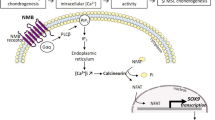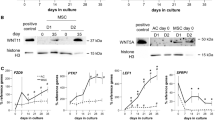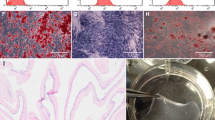Abstract
BACKGROUND:
Our previous studies found that the mechanical stimulation promote chondrogenic differentiation of bone marrow mesenchymal stem cells (BMSCs), along with up-regulation of thrombospondin-2 (TSP-2). The aim of this study was to explore the effect of thrombospondin-2 (TSP-2) on the mechanical pressure-stimulated chondrogenic differentiation of BMSCs and the possible role of NF-κB signaling in the mechano-chemical coupling regulation toward chondrogenesis.
METHODS:
Rat BMSCs were isolated, cultured and identified. The time-dependent expressions of TSP-2 and Sox9 in BMSCs under a dynamic mechanical pressure of 0–120 kPa at 0.1 Hz for 1 h were tested by qPCR and Western blotting. The role of TSP-2 in chondrogenic differentiation of BMSCs under mechanical pressure was validated by using small interfering RNA. The impact of TSP-2 and mechanical pressure on chondrogenesis were detected and the downstream signaling molecules were explored using Western blotting.
RESULTS:
Mechanical pressure stimulation of 0–120 kPa for 1 h significantly upregulated the expression of TSP-2 in BMSCs. The expression of the chondrogenesis markers Sox9, Aggrecan, and Col-II were all upregulated under dynamic mechanical pressure or TSP-2 stimulation. Additional exogenous TSP-2 may potentiate the chondrogenic effect of mechanical stimulation. After knock down TSP-2, the upregulation of Sox9, Aggrecan and Col-II under mechanical pressure was inhibited. The NF-κB signaling pathway responded to both dynamic pressure and TSP-2 stimulation, and the cartilage-promoting effect was blocked by an NF-κB signaling inhibitor.
CONCLUSION:
TSP-2 plays an essential role in the chondrogenic differentiation of BMSCs under mechanical pressure. NF-κB signaling is involved in the mechano-chemical coupling of TSP-2 and mechanical pressure for the chondrogenic differentiation of BMSCs.





Similar content being viewed by others
References
Cao W, Lin W, Cai H, Chen Y, Man Y, Liang J, et al. Dynamic mechanical loading facilitated chondrogenic differentiation of rabbit BMSCs in collagen scaffolds. Regen Biomater. 2019;6:99–106.
Schätti O, Grad S, Goldhahn J, Salzmann G, Li Z, Alini M, et al. A combination of shear and dynamic compression leads to mechanically induced chondrogenesis of human mesenchymal stem cells. Eur Cells Mater. 2011;22:214–25.
Kwon H, Brown WE, Lee CA, Wang D, Paschos N, Hu JC, et al. Surgical and tissue engineering strategies for articular cartilage and meniscus repair. Nat Rev Rheumatol. 2019;15:550–70.
Mollon B, Kandel R, Chahal J, Theodoropoulos J. The clinical status of cartilage tissue regeneration in humans. Osteoarthritis Cartilage. 2013;21:1824–33.
Elder BD, Athanasiou KA. Hydrostatic pressure in articular cartilage tissue engineering: from chondrocytes to tissue regeneration. Tissue Eng Part B Rev. 2009;15:43–53.
Lin W, Zhao Y, Cheng B, Zhao H, Miao L, Li Q, et al. NMDAR and JNK activation in the spinal trigeminal nucleus caudalis contributes to masseter hyperalgesia induced by stress. Front Cell Neurosci. 2019;13:495.
Bornstein P, Armstrong LC, Hankenson KD, Kyriakides TR, Yang Z. Thrombospondin 2, a matricellular protein with diverse functions. Matrix Biol. 2000;19:557–68.
de Fraipont F, Nicholson AC, Feige JJ, Van Meir EG. Thrombospondins and tumor angiogenesis. Trends Mol Med. 2001;7:401–7.
Stenina-Adognravi O. Invoking the power of thrombospondins: regulation of thrombospondins expression. Matrix Biol. 2014;37:69–82.
Kyriakides TR, Zhu YH, Yang Z, Bornstein P. The distribution of the matricellular protein thrombospondin 2 in tissues of embryonic and adult mice. J Histochem Cytochem. 1998;46:1007–15.
Jeong SY, Ha J, Lee M, Jin HJ, Kim DH, Choi SJ, et al. Autocrine action of thrombospondin-2 determines the chondrogenic differentiation potential and suppresses hypertrophic maturation of human umbilical cord blood-derived mesenchymal stem cells. Stem Cells. 2015;33:3291–303.
Jeong SY, Kim DH, Ha J, Jin HJ, Kwon SJ, Chang JW, et al. Thrombospondin-2 secreted by human umbilical cord blood-derived mesenchymal stem cells promotes chondrogenic differentiation. Stem Cells. 2013;31:2136–48.
Shin K, Cha Y, Ban YH, Seo DW, Choi EK, Park D, et al. Anti-osteoarthritis effect of a combination treatment with human adipose tissue-derived mesenchymal stem cells and thrombospondin 2 in rabbits. World J Stem Cells. 2019;11:1115–29.
Wang S, Hu T, Wang Z, Li N, Zhou L, Liao L, et al. Macroglia-derived thrombospondin 2 regulates alterations of presynaptic proteins of retinal neurons following elevated hydrostatic pressure. PLoS One. 2017;12: e0185388.
Hayden MS, Ghosh S. NF-κB, the first quarter-century: remarkable progress and outstanding questions. Genes Dev. 2012;26:203–34.
Kumar A, Takada Y, Boriek AM, Aggarwal BB. Nuclear factor-kappaB: its role in health and disease. J Mol Med (Berl). 2004;82:434–48.
Caron MM, Emans PJ, Surtel DA, Cremers A, Voncken JW, Welting TJ, et al. Activation of NF-κB/p65 facilitates early chondrogenic differentiation during endochondral ossification. PLoS One. 2012;7: e33467.
Liu JF, Chen PC, Chang TM, Hou CH. Thrombospondin-2 stimulates MMP-9 production and promotes osteosarcoma metastasis via the PLC, PKC, c-Src and NF-κB activation. J Cell Mol Med. 2020;24:12826–39.
Tan BK, Adya R, Chen J, Farhatullah S, Heutling D, Mitchell D, et al. Metformin decreases angiogenesis via NF-kappaB and Erk1/2/Erk5 pathways by increasing the antiangiogenic thrombospondin-1. Cardiovasc Res. 2009;83:566–74.
De Stefano D, Nicolaus G, Maiuri MC, Cipolletta D, Galluzzi L, Cinelli MP, et al. NF-kappaB blockade upregulates Bax, TSP-1, and TSP-2 expression in rat granulation tissue. J Mol Med (Berl). 2009;87:481–92.
Hahn C, Orr AW, Sanders JM, Jhaveri KA, Schwartz MA. The subendothelial extracellular matrix modulates JNK activation by flow. Circ Res. 2009;104:995–1003.
Shan S, Fang B, Zhang Y, Wang C, Zhou J, Niu C, et al. Mechanical stretch promotes tumoricidal M1 polarization via the FAK/NF-κB signaling pathway. FASEB J. 2019;33:13254–66.
Cheng B, Liu Y, Zhao Y, Li Q, Liu Y, Wang J, et al. The role of anthrax toxin protein receptor 1 as a new mechanosensor molecule and its mechanotransduction in BMSCs under hydrostatic pressure. Sci Rep. 2019;9:12642–52.
Huey DJ, Hu JC, Athanasiou KA. Unlike bone, cartilage regeneration remains elusive. Science. 2012;338:917–21.
Hodgkinson T, Kelly DC, Curtin CM, O’Brien FJ. Mechanosignalling in cartilage: an emerging target for the treatment of osteoarthritis. Nat Rev Rheumatol. 2022;18:67–84.
Kefauver JM, Ward AB, Patapoutian A. Discoveries in structure and physiology of mechanically activated ion channels. Nature. 2020;587:567–76.
Smith RM, Reilly GC. Mesenchymal stem cell responses to mechanical stimuli. Muscles Ligaments Tendons J. 2012;2:169–80.
Luo L, Foster NC, Man KL, Brunet M, Hoey DA, Cox SC, et al. Hydrostatic pressure promotes chondrogenic differentiation and microvesicle release from human embryonic and bone marrow stem cells. Biotechnol J. 2022;17:e2100401.
Zeng Y, Feng S, Liu W, Fu Q, Li Y, Li X, et al. Preconditioning of mesenchymal stromal cells toward nucleus pulposus-like cells by microcryogels-based 3D cell culture and syringe-based pressure loading system. J Biomed Mater Res B Appl Biomater. 2017;105:507–20.
Yue D, Zhang M, Lu J, Zhou J, Bai Y, Pan J. The rate of fluid shear stress is a potent regulator for the differentiation of mesenchymal stem cells. J Cell Physiol. 2019;234:16312–9.
Zhang M, Ono T, Chen Y, Lv X, Wu S, Song H, et al. Effects of condylar elastic properties to temporomandibular joint stress. J Biomed Biotechnol. 2009;2009:509848.
Zhao YH, Lv X, Liu YL, Zhao Y, Li Q, Chen YJ, et al. Hydrostatic pressure promotes the proliferation and osteogenic/chondrogenic differentiation of mesenchymal stem cells: The roles of RhoA and Rac1. Stem Cell Res. 2015;14:283–96.
Zhao Y, Yi FZ, Zhao YH, Chen YJ, Ma H, Zhang M. The distinct effects of estrogen and hydrostatic pressure on mesenchymal stem cells differentiation: involvement of estrogen receptor signaling. Ann Biomed Eng. 2016;44:2971–83.
Cheng B, Liu Y, Zhao Y, Li Q, Liu Y, Wang J, et al. The role of anthrax toxin protein receptor 1 as a new mechanosensor molecule and its mechanotransduction in BMSCs under hydrostatic pressure. Sci Rep. 2019;9:12642.
Moran CJ, Pascual-Garrido C, Chubinskaya S, Potter HG, Warren RF, Cole BJ, et al. Restoration of articular cartilage. J Bone Joint Surg Am. 2014;96:336–44.
Zhou M, Lozano N, Wychowaniec JK, Hodgkinson T, Richardson SM, Kostarelos K, et al. Graphene oxide: a growth factor delivery carrier to enhance chondrogenic differentiation of human mesenchymal stem cells in 3D hydrogels. Acta Biomater. 2019;96:271–80.
Zhen G, Guo Q, Li Y, Wu C, Zhu S, Wang R, et al. Mechanical stress determines the configuration of TGFβ activation in articular cartilage. Nat Commun. 2021;12:1706.
Song H, Park KH. Regulation and function of SOX9 during cartilage development and regeneration. Semin Cancer Biol. 2020;67:12–23.
Haseeb A, Kc R, Angelozzi M, de Charleroy C, Rux D, Tower RJ, et al. SOX9 keeps growth plates and articular cartilage healthy by inhibiting chondrocyte dedifferentiation/osteoblastic redifferentiation. Proc Natl Acad Sci U S A. 2021;118: e2019152118.
Caamaño J, Hunter CA. NF-kappaB family of transcription factors: central regulators of innate and adaptive immune functions. Clin Microbiol Rev. 2002;15:414–29.
Lawrence T. The nuclear factor NF-kappaB pathway in inflammation. Cold Spring Harb Perspect Biol. 2009;1:a001651.
Ilchovska DD, Barrow DM. An Overview of the NF-kB mechanism of pathophysiology in rheumatoid arthritis, investigation of the NF-kB ligand RANKL and related nutritional interventions. Autoimmun Rev. 2021;20:102741.
De Simone V, Franzè E, Ronchetti G, Colantoni A, Fantini MC, Di Fusco D, et al. Th17-type cytokines, IL-6 and TNF-α synergistically activate STAT3 and NF-kB to promote colorectal cancer cell growth. Oncogene. 2015;34:3493–503.
Jimi E, Fei H, Nakatomi C. NF-κB signaling regulates physiological and pathological chondrogenesis. Int J Mol Sci. 2019;20:6275.
De Luca F. Regulatory role of NF-κB in growth plate chondrogenesis and its functional interaction with Growth Hormone. Mol Cell Endocrinol. 2020;514:110916.
Novack DV. Role of NF-κB in the skeleton. Cell Res. 2011;21:169–82.
Wu S, Morrison A, Sun H, De Luca F. Nuclear factor-kappaB (NF-kappaB) p65 interacts with Stat5b in growth plate chondrocytes and mediates the effects of growth hormone on chondrogenesis and on the expression of insulin-like growth factor-1 and bone morphogenetic protein-2. J Biol Chem. 2011;286:24726–34.
Hou CH, Tang CH, Chen PC, Liu JF. Thrombospondin 2 promotes IL-6 production in osteoarthritis synovial fibroblasts via the PI3K/AKT/NF-κB pathway. J Inflamm Res. 2021;14:5955–67.
Chen X, Liu Y, Ding W, Shi J, Li S, Liu Y, et al. Mechanical stretch-induced osteogenic differentiation of human jaw bone marrow mesenchymal stem cells (hJBMMSCs) via inhibition of the NF-κB pathway. Cell Death Dis. 2018;9:207.
Barnabei L, Laplantine E, Mbongo W, Rieux-Laucat F, Weil R. NF-κB: at the borders of autoimmunity and inflammation. Front Immunol. 2021;12:716469.
Hayden MS, Ghosh S. Shared principles in NF-kappaB signaling. Cell. 2008;132:344–62.
Mitchell S, Vargas J, Hoffmann A. Signaling via the NFκB system. Wiley Interdiscip Rev Syst Biol Med. 2016;8:227–41.
Miao X, Yuan J, Wu J, Zheng J, Zheng W, Wang F, et al. Bone morphogenetic protein-2 promotes osteoclasts-mediated osteolysis via Smad1 and p65 signaling pathways. Spine (Phila Pa 1976) 2021;46:E234–42.
Ushita M, Saito T, Ikeda T, Yano F, Higashikawa A, Ogata N, et al. Transcriptional induction of SOX9 by NF-kappaB family member RelA in chondrogenic cells. Osteoarthritis Cartilage. 2009;17:1065–75.
Acknowledgements
This project was supported by the National Natural Science Foundation of China (81901052, 31971248) and the Shaanxi Science and Technology Innovation Team Project (2021TD-46).
Author information
Authors and Affiliations
Contributions
MZ and YZ conceived and supervised this project. JN, FF, SZ and YZ performed the cell culture and biochemical assays. RS and JL conducted the biomechanical experiments. LZ and HW performed the protein analysis. All authors analyzed the data and wrote the paper.
Corresponding authors
Ethics declarations
Conflict of interest
The authors declare no conflicts of interest.
Ethical statement
All animal procedures performed in this study were reviewed and approved by the Animal Experimental Ethical Inspection of Fourth Military Medical University (No. 2018023) and were performed in accordance with the guidelines of the International Association for the Study of Pain.
Additional information
Publisher's Note
Springer Nature remains neutral with regard to jurisdictional claims in published maps and institutional affiliations.
Supplementary Information
Below is the link to the electronic supplementary material.
Rights and permissions
Springer Nature or its licensor (e.g. a society or other partner) holds exclusive rights to this article under a publishing agreement with the author(s) or other rightsholder(s); author self-archiving of the accepted manuscript version of this article is solely governed by the terms of such publishing agreement and applicable law.
About this article
Cite this article
Niu, J., Feng, F., Zhang, S. et al. Thrombospondin-2 Couples Pressure-Promoted Chondrogenesis through NF-κB Signaling. Tissue Eng Regen Med 20, 753–766 (2023). https://doi.org/10.1007/s13770-023-00548-7
Received:
Revised:
Accepted:
Published:
Issue Date:
DOI: https://doi.org/10.1007/s13770-023-00548-7




